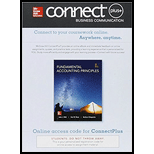
Concept Introduction:
Acid test ratio: Acid test ration is also called Quick ratio. This ratio is calculated by dividing the quick assets (Cash, Cash equivalents, Short term investments and current receivables) by total current liabilities for the year. The formula for Acid test ratio is as follows:
Days Sales in receivable ratio: This is an efficiency ratio that indicates the period for which credit sales remain as receivable. The ratio is calculated by dividing 365 days by the Accounts receivable turnover ratio. The formula to calculate this ratio is as follows:
Inventory Turnover Ratio: Inventory Turnover Ratio measures the efficiency of the company in converting its inventory into sales. It is calculated by dividing the Cost of goods sold by Average inventory. The formula of the Inventory Turnover Ratio is as follows:
Note: Average inventory is calculated with the help of following formula:
Day’s sales in inventory: Days sales in inventory represent the number of days the inventory waits for the sale. It is calculated by dividing the 365 days by Inventory Turnover Ratio. The formula of the Days sales in inventory is as follows:
Profit Margin Ratio:
Profit Margin Ratio is a profitability ratio that represents the percentage income earned on the sales. It is calculated by dividing the Net Income by the Sales. The formulas to calculate the Profit margin is as follows:
Asset Turnover Ratio:
Asset Turnover Ratio is an efficiency ratio that represents the sales earned on the average assets invested in the business. It is calculated by dividing the Sales by Average total assets. The formulas to calculate the Asset Turnover Ratio is as follows:
Return on total Assets: The Return on total assets is profitability ratio that measures the percentage of profit earned on average assets invested in the business. Return on asset is calculated by dividing the net income by average total assets. The formula to calculate Return on assets is as follows:
Note: Average total assets are calculated as an average of beginning and ending total assets. The formula to calculate the average total assets is as follows:
Return on Common Stockholder’s Equity:
Return on Equity is the rate of return earned by the Stockholders on their investment in the company. It is calculated with the help of following formula:
The Average stock holder’s equity calculated with the help of following formula:
Price Earnings Ratio:
The price earnings ratio shows the relationship between price of the share and earnings per share. It is calculated with the help of following formula:
Dividend Yield Ratio:
Dividend Yield ratio is calculated as percentage by dividing the Dividend per share by Market price per share. The formula for the Dividend Yield ratio is as follow:
Requirement-1:
To determine: Current ratio, acid test ratio, accounts receivable turnover, inventory turnover, and day’s sales in inventory and, days sales uncollected for both the companies.
Requirement-2:
To determine: Profit margin ratio, total asset turnover ratio, return on total asset, return on common stock holder’s equity, price earnings ratio and, dividend yield for both the companies.
Want to see the full answer?
Check out a sample textbook solution
Chapter 17 Solutions
Connect 2-Semester Access Card for Fundamental Accounting Principles
- Please explain the solution to this general accounting problem with accurate principles.arrow_forwardKindly help me with this General accounting questions not use chart gpt please fast given solutionarrow_forwardI am searching for the correct answer to this Financial accounting problem with proper accounting rules.arrow_forward
- I am looking for the correct answer to this Financial accounting question with appropriate explanations.arrow_forwardEcho Tone Technologies reports annual sales of $90,000, and it expects sales to increase to $135,000 next year. The company has a degree of operating leverage (DOL) of 4.2. By what percentage should net income increase? A. 70% B. 189% C. 150% D. 210%arrow_forwardPlease provide the solution to this general accounting question using proper accounting principles.arrow_forward
- No chatgpt Which account will appear in the post-closing trial balance?A. Rent ExpenseB. Sales RevenueC. DividendsD. Capitalarrow_forwardI need help with this financial accounting question using the proper accounting approach.arrow_forwardI need help Which account will appear in the post-closing trial balance?A. Rent ExpenseB. Sales RevenueC. DividendsD. Capitalarrow_forward

 AccountingAccountingISBN:9781337272094Author:WARREN, Carl S., Reeve, James M., Duchac, Jonathan E.Publisher:Cengage Learning,
AccountingAccountingISBN:9781337272094Author:WARREN, Carl S., Reeve, James M., Duchac, Jonathan E.Publisher:Cengage Learning, Accounting Information SystemsAccountingISBN:9781337619202Author:Hall, James A.Publisher:Cengage Learning,
Accounting Information SystemsAccountingISBN:9781337619202Author:Hall, James A.Publisher:Cengage Learning, Horngren's Cost Accounting: A Managerial Emphasis...AccountingISBN:9780134475585Author:Srikant M. Datar, Madhav V. RajanPublisher:PEARSON
Horngren's Cost Accounting: A Managerial Emphasis...AccountingISBN:9780134475585Author:Srikant M. Datar, Madhav V. RajanPublisher:PEARSON Intermediate AccountingAccountingISBN:9781259722660Author:J. David Spiceland, Mark W. Nelson, Wayne M ThomasPublisher:McGraw-Hill Education
Intermediate AccountingAccountingISBN:9781259722660Author:J. David Spiceland, Mark W. Nelson, Wayne M ThomasPublisher:McGraw-Hill Education Financial and Managerial AccountingAccountingISBN:9781259726705Author:John J Wild, Ken W. Shaw, Barbara Chiappetta Fundamental Accounting PrinciplesPublisher:McGraw-Hill Education
Financial and Managerial AccountingAccountingISBN:9781259726705Author:John J Wild, Ken W. Shaw, Barbara Chiappetta Fundamental Accounting PrinciplesPublisher:McGraw-Hill Education





